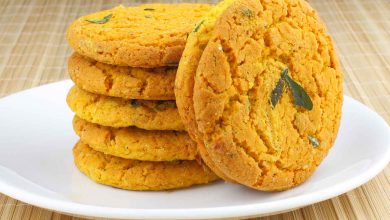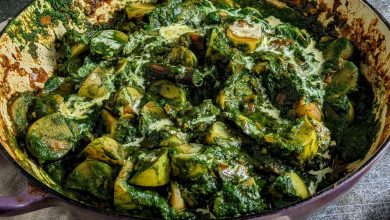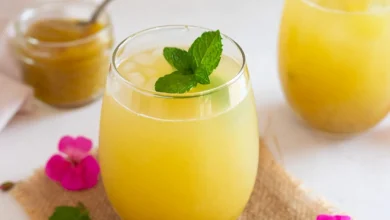Kerala Cherupayar Curry Recipe (Green Moong and Yellow Moong Dal Curry)
Kerala Cherupayar Curry is a soul-soothing dish that beautifully combines the rich flavors of green mung beans (green moong dal) and yellow mung beans (split yellow moong dal). In Malayalam, “Cherupayar” refers to green moong lentils, a staple in Kerala’s cuisine. This hearty curry is infused with the goodness of fresh coconut and aromatic spices, enhanced with a drizzle of coconut oil that ties the flavors together in a comforting embrace. A powerhouse of nutrients, mung beans are a rich source of fiber, protein, and antioxidants, making this curry both delicious and nourishing.
This versatile dish can be enjoyed with steamed rice, Kerala’s iconic puttu, or soft phulkas, making it perfect for lunch or a comforting dinner.
Ingredients
| Ingredient | Quantity |
|---|---|
| Green Moong Dal (Whole) | 1 cup |
| Yellow Moong Dal (Split) | 1/2 cup |
| Pearl Onions (Sambar Onions) | 10 |
| Mustard Seeds (Rai/ Kadugu) | 1 teaspoon |
| Curry Leaves | 1 sprig |
| Dry Red Chilli | 2 |
| Turmeric Powder (Haldi) | 1 teaspoon |
| Salt | To taste |
| Coconut Oil | For cooking |
To Grind:
| Ingredient | Quantity |
|---|---|
| Fresh Coconut | 1/2 cup |
| Green Chilli | 2 |
| Cumin Seeds (Jeera) | 1 teaspoon |
Preparation Time: 60 minutes
Cooking Time: 30 minutes
Course: Lunch
Cuisine: Kerala Recipes
Diet: High Protein Vegetarian
Nutritional Information
Approximate values per serving
| Nutrient | Amount |
|---|---|
| Calories | 220 kcal |
| Protein | 12 g |
| Carbohydrates | 30 g |
| Fiber | 8 g |
| Fat | 6 g |
| Saturated Fat | 2 g |
| Sodium | 200 mg |
| Iron | 2 mg |
Instructions
-
Soak and Cook the Green Moong Dal:
- Begin by soaking the green moong dal (whole mung beans) in water for at least 2 hours to soften them.
- Drain and transfer the soaked beans to a pressure cooker. Add water and cook on medium heat for about 4 whistles until the beans are tender. Allow the pressure to release naturally before opening the lid.
-
Cook the Yellow Moong Dal:
- In the same pressure cooker, cook the yellow moong dal. Add water and a teaspoon of turmeric powder. Pressure cook for 4 whistles.
- Once done, allow the pressure to release naturally. Open the cooker and mash the yellow moong dal into a smooth paste using the back of a spoon.
-
Prepare the Curry Base:
- Heat a kadai (deep pan) over medium heat and add a generous amount of coconut oil.
- Once the oil is hot, add mustard seeds and let them splutter. Quickly add the curry leaves and be cautious, as they tend to splutter vigorously.
- Add the pearl onions (whole or halved, as preferred) and sauté until they turn soft and slightly golden.
-
Combine the Lentils:
- Add the mashed yellow moong dal to the pan, followed by the cooked green moong dal. Mix well to combine. Reduce the heat to low and let the mixture simmer gently.
-
Prepare the Coconut Paste:
- In a blender, grind fresh coconut, green chilies, and cumin seeds into a smooth paste. Add a little water as needed to achieve a fine consistency.
-
Incorporate the Coconut Paste:
- Add the ground coconut paste to the simmering dal mixture. Stir well to incorporate all the flavors. Adjust the salt to taste.
-
Simmer and Finish:
- Allow the curry to simmer for another 10 minutes on low heat, letting the flavors meld together beautifully. Turn off the heat and drizzle with a little more coconut oil for that authentic Kerala touch.
-
Serve:
- Serve the Kerala Cherupayar Curry hot with puttu, steamed rice, or soft phulkas. It also makes a delightful addition to a lunch box.
Chef’s Notes
- To elevate the flavor, you can add a pinch of hing (asafoetida) while tempering with mustard seeds.
- Adjust the consistency of the curry by adding more water while simmering, depending on whether you prefer it thicker or soupier.
- Pearl onions add an authentic Kerala flavor, but regular onions can be used as a substitute if needed.
Enjoy this Kerala classic with its wholesome, earthy flavors and aromatic appeal—a true celebration of the region’s culinary heritage!





